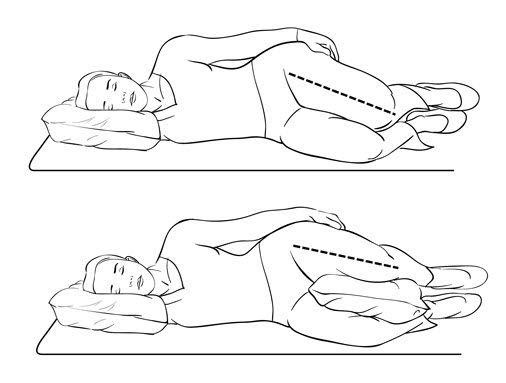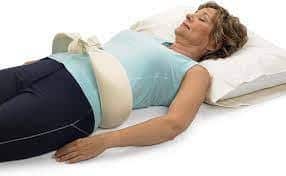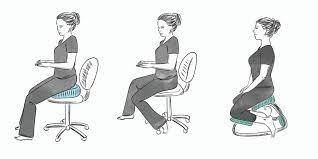Pandemic has entirely shifted workforce to online at home service. In these times, sitting prolonged on a chair working with your back rounded. Slouched posture/C curve puts a lot of stretch on discs, ligaments stretched out beyond their limit.
Even after work, you just casually binge over Netflix, still in a twisted posture. You call it your comfort position, but in reality, it’s putting stress and tension on your muscles, nerves and ligaments.
Factors that Trigger sciatica
Being in any position, chore, posture, movement for a long time, or injury causes sciatica.
- Scrolling through the phone with forwarding neck posture
- Getting up from bed while lifting your back first
- Picking up something or lifting a heavy object from the ground by just bending your trunk
- Cleaning house with rounding back or lifting a heavy object from the ground
You see no problem doing these daily activities with abnormal positions. You have got been doing these for years and don’t see anything wrong with it.
However, with time your ligaments and muscles have started to develop tiny tears in them, which are unnoticeable initially but gradually affect your day to day routine.
Old age is one factor that decreases the tensile strength in ligaments. In addition to that, lousy posture or movement over decades causes damage to the musculoskeletal structure.
Often times it can increase in severity if not treated on time. Taking action and consulting your Physical therapist is always a better idea than treating yourself at home.
So to allow you to understand this better, let me tell you what sciatica is?
You have undoubtedly heard someone, maybe yourself having sciatica. This Umbrella term usually describes any pain in the low back and causes irritation to some part of the sciatic nerve.
Usually shooting pain accompanied by numbness and tingling sensation in the butt, back or thigh. Sciatica is basically pain, tingling and numbness that originates in your back and travels down along with the course of the nerve. It is a symptom, not a diagnosis!
Causes of sciatica
While there are various causes of sciatica such as nerve impingement, herniation and muscular imbalance, promoting movement along that nerve can help minimize your symptoms and provide temporary relief.
Doing so will provide you a window of opportunity to perform other rehab exercises to help with your sciatica.
Some of the causes of sciatica are listed below;
- Bulging (nerve root that is being swelled or pinched)
- Joint inflammation (it compresses nerve)
- Stenosis (narrowing of a canal through which the nerve passes)
- SI joint paint
- Piriformis tightness (the sciatic nerve passes between this muscle when it becomes tight, it pinches the nerve)
Best Sleeping position with sciatica
Find the correct position to sleep where you are comfortable, and it’s the most important thing. As it releases pressure on your back
- Make sure your back is in a neutral position
- The mattress isn’t saggy
- No rounded out back posture
- Don’t sleep in foetal position
Sleeping on your stomach.
It affects the curve in your back, causing irritation to the nerve and inflammation of adjacent structures, making your pain worse. While Lying on your back, your neck Is also twisted to one side. It not only triggers back issue but it also causes musculoskeletal problems in your upper and middle back.
Do whatever you can do and try to break this habit
Side sleepers
Find a pillow that supports your head in a neutral straight position. It shouldn’t be higher or lower than that.
If you are a side sleeper, you can just put a pillow between your legs and a small pillow under the hollow arch of your back. It keeps the spine aligned in a neutral position and stops it from rotating. It is also known as stacked position, as legs are stacked over one another.

Sleeping directly on your back
Keep pillows underneath your knees and your back. It takes pull from the hamstring at the back of your leg and keeps the spine in a neutral straight position. Taking away a lot of pressure off the back.
This is the best position to sleep in with sciatica.
Another thing you can do is sleep on the floor. Lie flat and keep pillows underneath your back and knees
People who sleep on their back Put a pillow or wedge underneath their knees. You can use 2 pillows depending on your height and body weight.

As suggested by Brian Mulligan. Take a long sheet of fabric, roll it out and wrap it around your back. It will help with rounded back posture. Keeping the arch of the back in a neutral position.
It also keeps your back aligned while laying down on your back or on your side. Preventing back from sagging down
You can also use McKenzie Lumbar sleep roll for better results.As suggested by Brian Mulligan. Take a long sheet of fabric, roll it out and wrap it around your back. It will help with rounded back posture. Keeping the arch of the back in a neutral position.
It also keeps your back aligned while laying down on your back or on your side. Preventing back from sagging down
You can also use McKenzie Lumbar sleep roll for better results.

How to get up from bed?
It is important to keep back straight and reduce strain while getting up from bed. Do not just straight uplift your trunk when you are lying on your back. It puts a ton of pressure and stress on your lower back. Which could possibly cause disc herniation, indicating the symptoms of sciatica
You can do it like this instead;
- No matter in what position you are in, turn into a side-lying position.
- Bend knees partially, drape them over the side of the bed. Your legs are hanging off the bed
- Press up with your opposite hand onto the bed and lift your trunk while keeping your back straight
Best sitting posture with sciatica
First of all, you have to correct your sitting posture. If you sit In a slouched posture while using your laptop or scrolling through your phone, take measures to fix it asap! This posture builds continuous tension and strain in your lower back, putting a stretch on the sciatic nerve.
While sitting, try to keep your pelvis tilted anteriorly. It keeps the spine in a natural curve that we want to keep in.
Look for a chair with a seat pan that tilts forward, or if your chair is adjustable, look for the lever underneath the chair and raise the seat pan a little forward. Adjust the lever according to your level of comfort. It puts your pelvis in an anterior tilt.
Don’t go for chairs that tilt backwards as they aggravate sciatica making pain worse.
Even better, you can use a seat wedge. It is thin in the front and 2 or 3-inch-thick at the back. It keeps your spine in an ergonomically neutral position. Combining it with lumbar support gives the best results. As it helps maintain the arch at the lower back in a nice neutral position while sitting.
You can use a small pillow to raise the chair a bit forward and roll a towel to support your back.

Exercises for sciatica
Following are some of the tried and tested home exercises that gave excellent results.
Cat/Camel mobility exercise
Sciatic Flossing
Sciatic sliders
Sciatic tensioners
Slump nerve slide
Pelvic tilts
Back extension
Knee to chest
